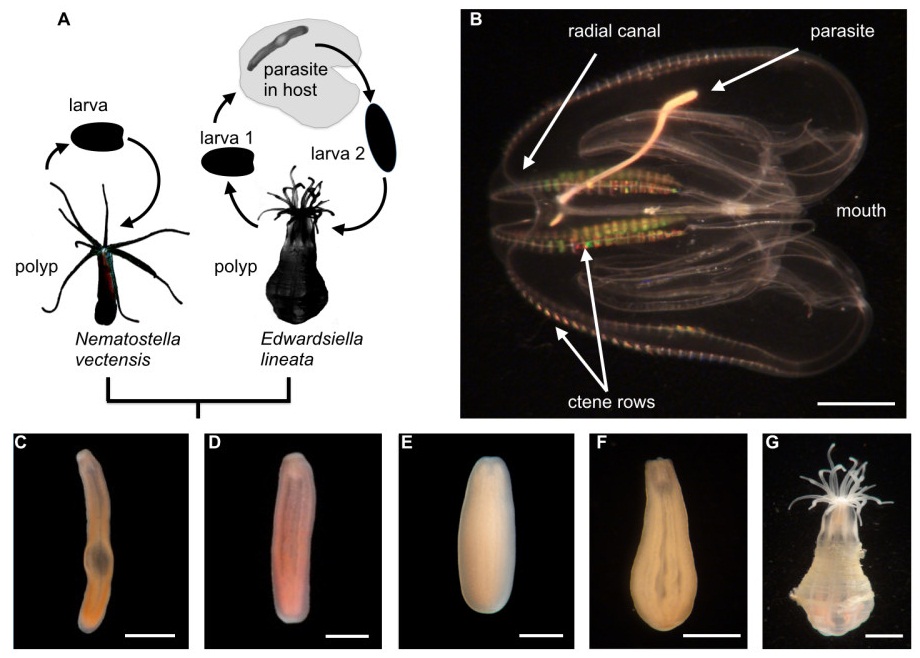Soccer tackles male obesity • Selection or infection? • Aspiring for a healthier baby • Grassland management influences biodiversity • Life cycle of a parasitic sea anemone • Report raises awareness about poor awareness of reporting • Notch signalling in review • Improved lung function in COPD • How to share unpublished data
 Health: Soccer tackles male obesity
Health: Soccer tackles male obesity
A men-only weight management program delivered to groups at top professional football clubs attracts men at high risk of ill-health who may otherwise be reluctant to attend existing weight management programs. A mixed-methods study involving almost 750 men enrolled in the Football Fans in Training (FFIT) programme finds that participants appreciated being given the opportunity to undertake weight management related to something they valued highly, in a scheme that fostered team spirit with people in similar circumstances. Find out more from one of its members, over in the Guardian.
Evolution: Selection or infection?
Female mice allowed to choose their mate produce offspring that are better able to survive infection than offspring of females mating with non-preferred males. The offspring from preferred males showed no difference in their ability to combat infection from Salmonella compared to offspring from non-preferred males, suggesting that these effects are not related to pathogen resistance, but that mate choice may enhance the ability to cope with infection.
Pregnancy: Aspiring for a healthier baby
The desire to further one’s education is associated with better birth outcome in pregnant adolescents. Data from the US National Longitudinal Study of Adolescent Health finds that those with higher educational aspiration who had skipped a grade at some point during school gave birth later, and had children with higher birthweight, compared to other adolescents. The authors of the study argue that better investment in adolescent educational opportunities could therefore lead to improved birth outcomes for teenagers.
Ecology: Grassland management influences biodiversity
To improve the productivity of livestock like dairy cattle, agricultural grassland may be intensified through the application of fertilizers to increase yield and cutting frequencies during the growing seasons. However, this regime may have negative influences on the biodiversity of these habitats, since other plant and animal species are linked within a network of complex trophic interactions. A new study reviewed for BMC Ecology via the community peer-review initiative Peerage of Science investigates these interactions by utilising experimental grassland communities grown under different intensification conditions to show that species richness of insect leafhoppers is negatively affected by higher cutting frequencies, but positively affected by increased grass cover.
Image of the month
 Life cycle of the parasitic sea anemone Edwardsiella lineata. A. Comparison of the life cycles between free-living and parasitic sea anemones B. Ctenophore infected with E. lineata. C-G. Stages in the life cycle of E. lineata. From Stefanik et al. BMC Genomics
Life cycle of the parasitic sea anemone Edwardsiella lineata. A. Comparison of the life cycles between free-living and parasitic sea anemones B. Ctenophore infected with E. lineata. C-G. Stages in the life cycle of E. lineata. From Stefanik et al. BMC Genomics
Veterinary research: Report raises awareness about poor awareness of reporting
An online survey of Editors-in-Chief from 185 veterinary research journals reveals that only half of respondents had previous knowledge of community reporting guidelines such as ARRIVE (Animal Research: Reporting In Vivo Experiments), with only two-thirds of respondents believing that such guidelines need to be adopted by all refereed veterinary journals. Knowledge, fear, resistance to change, and difficulty in implementation were all perceived as barriers to the adoption of reporting guidelines by these journals, suggesting that better communication and education is needed in order for the community to adopt a unified approach to best practice.
Developmental biology: Notch signalling in review
Notch proteins span the cell membrane and are involved in signal communication between cells. They act in nearly every tissue in multicellular animals, playing a crucial role in a number of developmental pathways. In a new Review for BMC Developmental Biology, Shahragim Tajbakhsh and Philippos Mourikis outline the role of Notch signalling in skeletal muscle stem cells and discuss the importance of cellular context in determining the outcome of this activity.
Pulmunology: Improved lung function in COPD
Umeclidinium bromide (UMEC), an inhaled agent that facilitates relaxation of airway smooth muscle, improves lung function over 24 hours in patients with moderate-to-severe chronic obstructive pulmonary disease (COPD). A randomised crossover study involving more than 150 patients finds that this drug, an inhaled long-acting muscarinic antagonist, demonstrated improved lung function in patients over a range of doses compared to placebo, but not when compared to an open-label alternative, Tiotropium.
Genomics: How to share unpublished data
An update to editorial guidelines on the fair use of unpublished genomic data in BMC Genomics articles prompts to the Biology Editors at BioMed Central to reflect on best practice for users and data generators, emphasising the importance of good communication and clear guidelines.
![]() Follow @BMC_series
Follow @BMC_series
![]() Watch our YouTube channel
Watch our YouTube channel
![]() Browse our list of journals
Browse our list of journals
![]() Subscribe to updates from the blog
Subscribe to updates from the blog
Comments